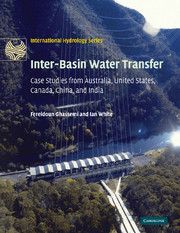Book contents
- Frontmatter
- Contents
- Foreword
- Overview and Scope
- Acknowledgements
- List of Abbreviations
- Part I The Challenges
- 1 World population and pressures on land, water and food resources
- 2 Issues in inter-basin water transfer
- Part II Inter-basin Water Transfer in Australia
- Part III Inter-basin Water Transfer in Other Selected Countries
- Part IV Appendices
- Glossary
- Index
- References
2 - Issues in inter-basin water transfer
Published online by Cambridge University Press: 05 November 2009
- Frontmatter
- Contents
- Foreword
- Overview and Scope
- Acknowledgements
- List of Abbreviations
- Part I The Challenges
- 1 World population and pressures on land, water and food resources
- 2 Issues in inter-basin water transfer
- Part II Inter-basin Water Transfer in Australia
- Part III Inter-basin Water Transfer in Other Selected Countries
- Part IV Appendices
- Glossary
- Index
- References
Summary
INTRODUCTION
A significant portion of the world's limited freshwater resources have already been developed to supply the increasing world population with water for drinking, sanitation, production of food and fibre, flood control and hydro-power generation. Developments have included inter-basin water transfer, construction of dams, canals, pipelines, pumping stations, and well fields for groundwater extraction. As the world approaches the limits of its finite freshwater resources, efforts are being increasingly directed towards their better management through improving water use efficiency, recycling of used water, improved laws and the establishment of a water market.
Globally, many water resources development projects have been criticised for their negative environmental, social and cultural impacts, as well as their poor economic performances (Petts, 1984; Goldsmith and Hildyard, 1984; Blackwelder and Carlson, 1986; Pearce, 1992). The World Bank also has been criticised for funding numerous large-scale water resources development projects around the world, resulting in environmental degradation, population displacements, and unrealised economic outcomes. Following these criticisms, the World Bank developed policies and guidelines for the environmental and social assessment of its various projects, including water resources development prior to any future funding (World Bank, 1991a, b, c).
The World Commission on Dams (WCD) has undertaken the most recent critical review of the large dams around the world. It started its activities in May 1998 by:
(1) creating a 68 member stakeholder forum;
(2) drawing on the wider stakeholder community of experts and analysts in developing the WCD knowledge base;
(3) undertaking a programme of four regional consultations in different parts of the world with participation of 1400 individuals from 59 countries;
[…]
- Type
- Chapter
- Information
- Inter-Basin Water TransferCase Studies from Australia, United States, Canada, China and India, pp. 22 - 48Publisher: Cambridge University PressPrint publication year: 2007

